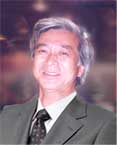 |
Professor Graduate School of Engineering Tohoku University Address Tel & Fax : +81-22-795-5868 |
 |
Professor Graduate School of Engineering Tohoku University Address Tel & Fax : +81-22-795-5868 |
| Background In a physical universe comprising the solid, liquid, gaseous and plasma states of matter, it is natural that many important phenomena take place at the interfaces of these states. Concerning the interfaces between solids and liquids, some very common examples include the corrosion of metals, the charging and discharging of a storage battery, and the wet processing of semiconductor devices. Many such processes involve electrochemical oxidation-reduction reactions. Although these and related phenomena have long been studied, until recently knowledge concerning the atomic and molecular processes that occur at the interfaces have depended on indirect experiments. One of the major reasons for this is that there has been no good observational technique that could work in a liquid. Thus, most previous information resulted from observations made in a high vacuum after removing a solid sample from a liquid. During this process irreversible reactions, such as surface oxidation and contamination, often occur, thus complicating the analysis of surface structures. Recently, however, techniques involving scanning tunneling microscopy (STM) and atomic force microscopy (AFM) have been extended to observations of solid samples immersed in liquids, thus allowing direct observation of the solid/liquid interface in its reacting state. On of the most important advancements in this field is a system called electrochemical STM developed by Kingo Itaya. In this system having a four-electrode configuration, the electrode potentials of the substrate and the tip can be independently controlled relative to a reference electrode. This apparatus thus offers new possibilities for complete in situ observations of electrochemical reactions under potentiostatic conditions, since the tip can be continuously scanned over a surface, even while electrochemical reactions are occurring at the working electrode. The Itaya Laboratory is using these new techniques to examine electrochemistry at the atomic and molecular levels. The laboratory is treating the solid/liquid interface as a reaction site in order to uncover the mechanisms of surface reactions while pursuing the precise control of these reactions. Analysis is focusing particularly on the reactivity and structure of solid surfaces in the presence of adsorbed ions and solvent layers. Research Strategy Regarding interface formation, work is concentrating on the bond-formation reactions which occur at the solid/liquid interface. For example, the mechanisms by which metal and semiconductor surfaces are electrochemically formed and dissolved, thin-film crystal growth processes, as well as the adsorption and orientation of ions and molecules are being pursued. In addition, the formation of modified surfaces and new methods for making thin films using knowledge gained about reactions at the solid/liquid interface is being studied. Another area of concentration concerns interface fabrication,
while concentrating on reactions that break bonds at the solid/liquid
interface. The processes involved in chemical and electrochemical etching
as well as in dissolving adsorbed molecular layers should hopefully
be clarified. To this end, the electrochemical energy and optical energy
necessary to control reactions at the solid/liquid interface are being
applied. A search for technology to control metal and semiconductor
surfaces at the atomic and molecular levels is also being conducted.
|